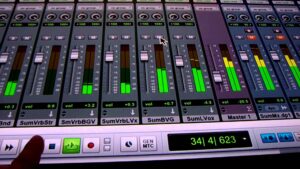 Whether you’re an experienced audio engineer or an aspiring music producer, efficiency and consistency are important. Maximizing your workflow can lead to better results and save valuable time. One powerful tool that can significantly enhance your mixing process is the Pro Tools mixing template. What is a mixing template is and why should you consider using one?
Whether you’re an experienced audio engineer or an aspiring music producer, efficiency and consistency are important. Maximizing your workflow can lead to better results and save valuable time. One powerful tool that can significantly enhance your mixing process is the Pro Tools mixing template. What is a mixing template is and why should you consider using one?
What is a Mixing Template?
A mixing template in Pro Tools is a pre-configured session file that includes a set of tracks, plugins, routing configurations, and settings that you commonly use in your mixing projects. Think of it as a blueprint for your mixing sessions. Instead of starting from scratch every time you begin a new project, a mixing template provides a ready-made framework that can be tailored to the specific needs of the song you’re working on.
Components of a Mixing Template
- Track Layout: Pre-set tracks for drums, bass, guitars, vocals, and other instruments.
- Plugins and Effects: Commonly used EQs, compressors, reverbs, and delays are already inserted.
- Routing and Buses: Pre-configured signal routing, including buses for drums, vocals, and effects.
- Markers and Labels: Marked sections for verses, choruses, bridges, and other song parts for easy navigation.
Why Use a Mixing Template?
- Speed: With a template, you don’t have to set up your session from scratch every time. This can save hours over the course of multiple projects.
- Workflow: A template ensures that your sessions are organized in a familiar way, allowing you to jump into the creative process immediately.
- Consistency: Using the same starting point for each mix can help maintain a consistent sound across an album or multiple projects, which is especially important for artists looking to establish a signature sound. Consistent track naming, routing, and plugin usage make collaboration with other engineers easier and more seamless.
- Creativity: With technical setup out of the way, you can focus more on the artistic aspects of mixing, such as balancing levels, sculpting tones, and adding creative effects. Having a reliable base setup allows you to experiment with new plugins and techniques without losing track of the core elements of your mix.
- Organization: Pre-labeled tracks and organized buses keep your session tidy, making it easier to find and adjust elements as needed. If something goes wrong, a standardized setup makes it easier to diagnose and fix issues.
- Adaptability: While a template provides a solid starting point, it can always be adjusted and customized to fit the specific needs of each project. This adaptability ensures that your workflow can evolve as you incorporate new techniques and technologies.
How to Create a Pro Tools Mixing Template
- Set Up Your Session: Start by setting up a new session with all the tracks, plugins, and routing configurations you commonly use.
- Save as Template: Once your session is configured to your liking, save it as a template. In Pro Tools, you can do this by selecting `File > Save As Template`.
- Refine and Update: As you develop new techniques or preferences, update your template to reflect these changes.
Conclusion
A Pro Tools mixing template is a game-changer for anyone serious about audio production. It streamlines the technical setup process, ensures consistency across projects, and allows you to focus more on the creative aspects of mixing. By investing a little time upfront to create a comprehensive mixing template, you can reap significant long-term benefits in efficiency, organization, and overall production quality. Embrace the power of templates, and watch your mixing workflow transform.